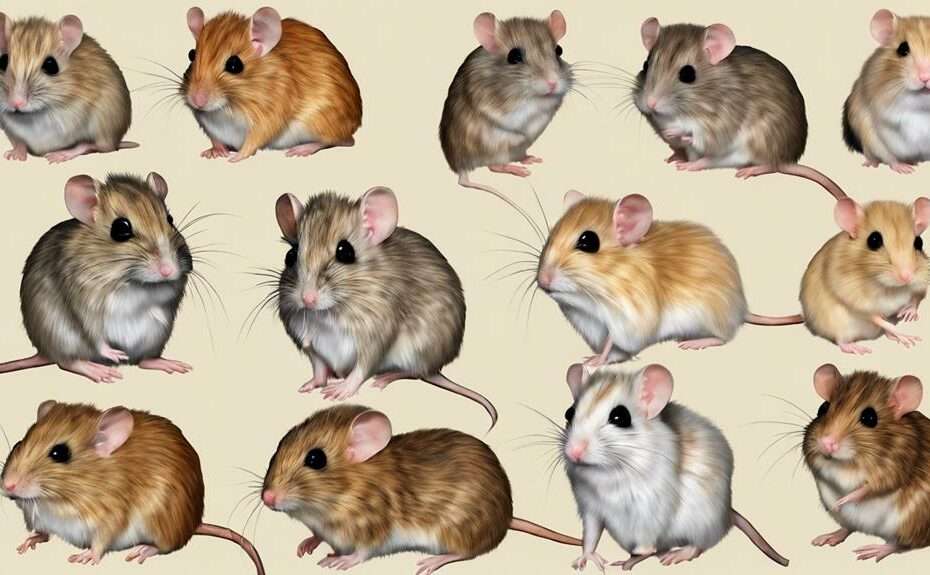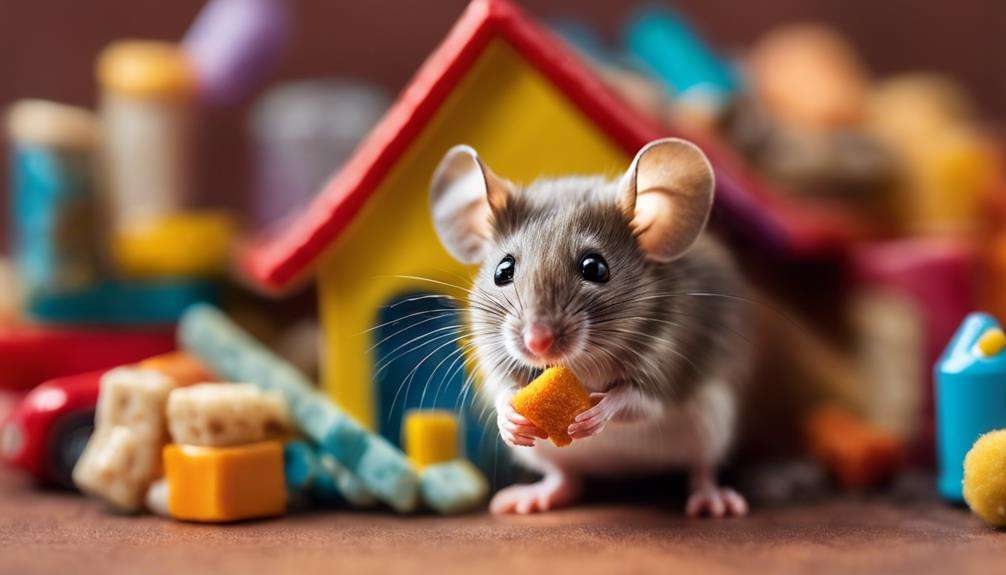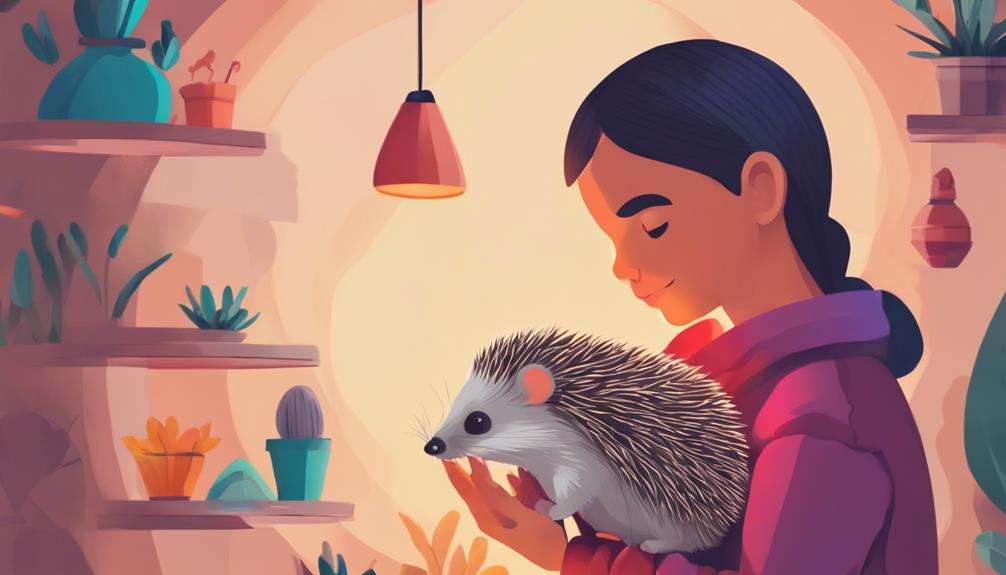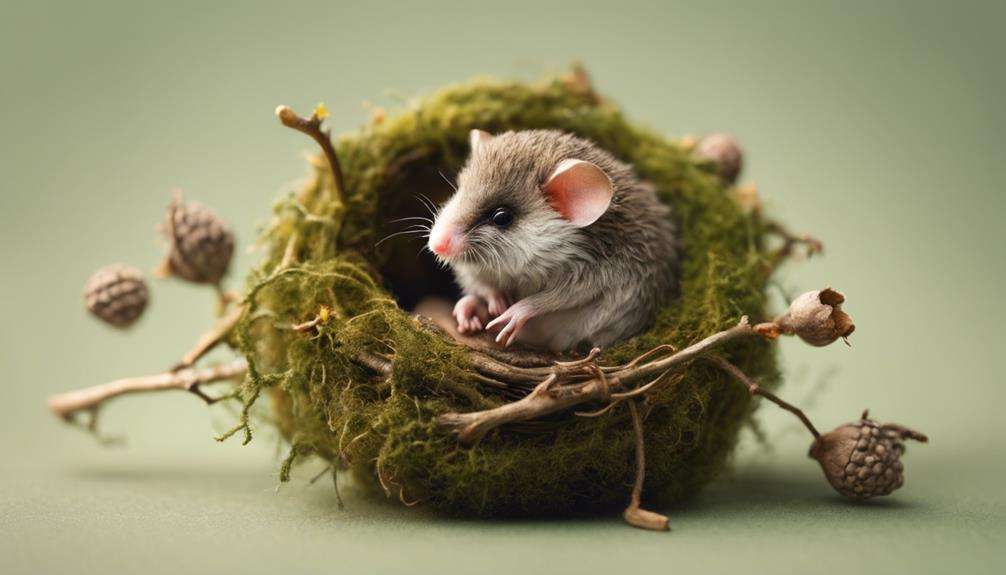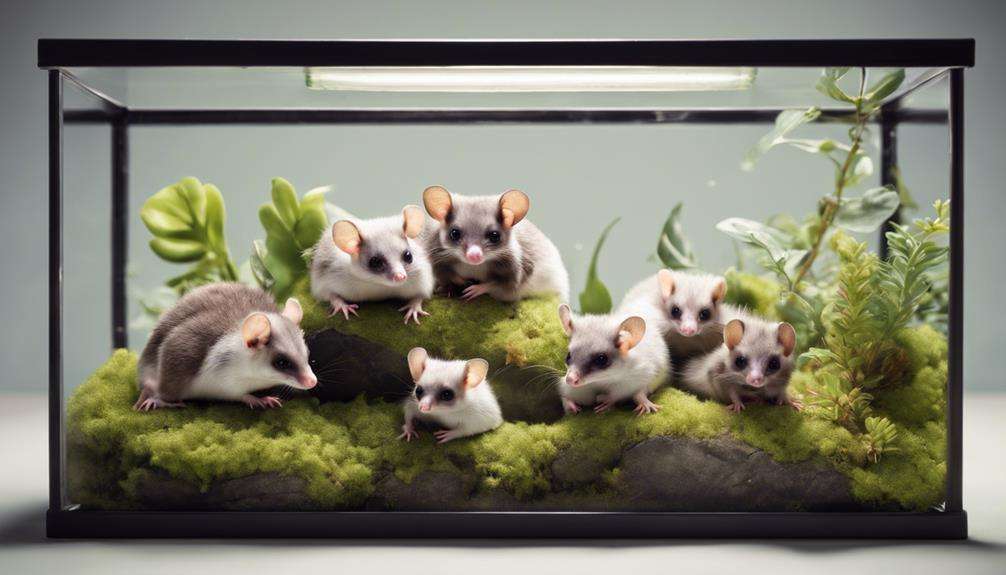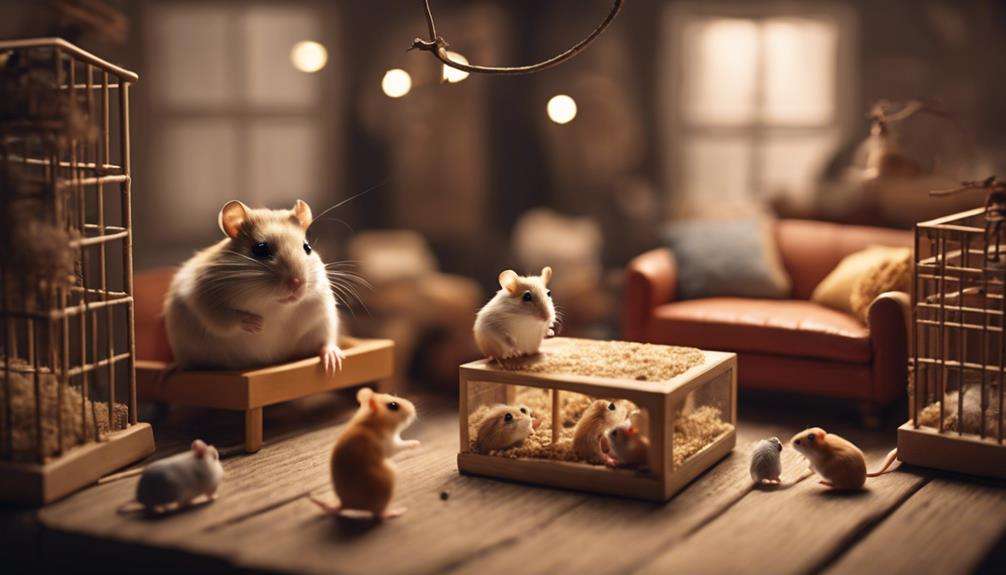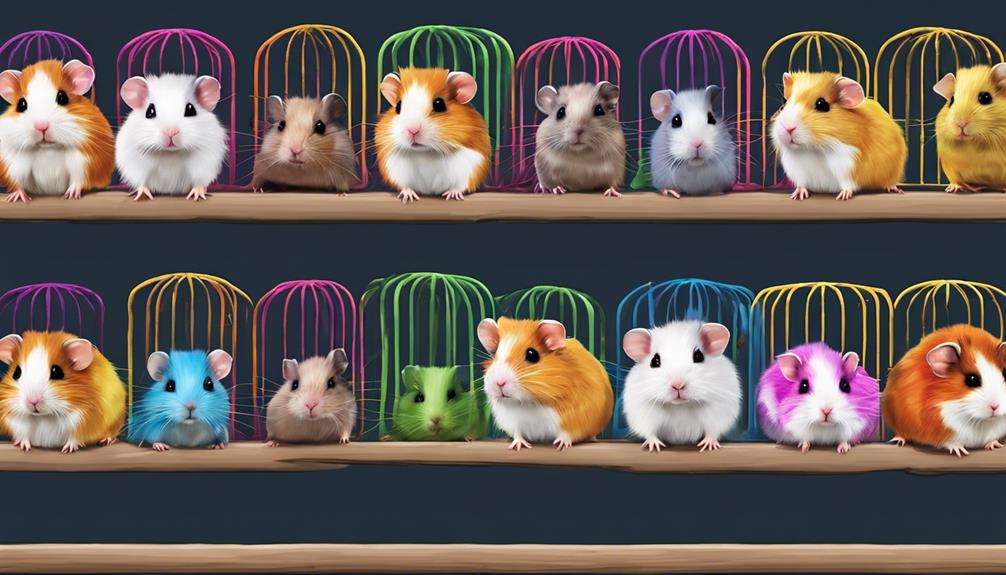You might think you know all about common pet rodents, but have you ever heard of the Pygmy Jerboa or the Brush-Tailed Bettong? These lesser-known breeds offer a fascinating glimpse into the world of small rodents, each with its quirks and unique traits waiting to be discovered.
From the agility of the Chinese Hamster to the endearing nature of the Russian Dwarf Hamster, there's a surprise in store with each of these 10 breeds that might just pique your interest in the diverse world of small rodent companions.
Key Takeaways
- Small rodents like Pygmy Jerboas and Egyptian Spiny Mice have unique physical features and exceptional abilities.
- African Pygmy Mice and Chinese Hamsters originate from distinct regions, each with special characteristics and care needs.
- Rodents like Short-Tailed Chinchillas and Brazilian Guinea Pigs require specific care due to their unique fur and habitat requirements.
- Species like Richardson's Ground Squirrels and Brush-Tailed Bettongs exhibit fascinating behaviors and habitat considerations.
Pygmy Jerboa
Pygmy jerboas, small rodents native to the deserts of Northern Africa and Asia, are known for their unique appearance and exceptional jumping abilities. These small creatures are a marvel of nature, with their defining features being their small size and remarkably long hind legs. The elongated hind limbs of the pygmy jerboa are specially adapted for efficient hopping, allowing them to traverse the sandy terrain of their desert habitat with ease.
Their long hind legs enable pygmy jerboas to engage in powerful jumps, propelling them several times their body length in a single bound. This remarkable ability serves them well in evading predators and accessing food sources in the challenging desert environment. Despite their diminutive stature, pygmy jerboas are agile and swift, relying on their jumping prowess for survival in the harsh desert landscapes they call home.
African Pygmy Mouse
The African Pygmy Mouse, a fascinating small rodent native to sub-Saharan Africa, captivates with its diminutive size and delicate features. Measuring around 3-4 inches, these tiny mice are known for their curious and active nature. In captivity, they can live for 2-4 years when provided with proper care and a suitable environment.
These social animals thrive in same-sex pairs or small groups, enjoying companionship and interaction. To keep them happy and healthy, thus provide a well-equipped cage with hiding spots, toys, and opportunities for exploration. African Pygmy Mice are inquisitive creatures that benefit greatly from mental stimulation and physical activity.
Observing these mice in their social interactions can be quite rewarding, as they communicate through various sounds and body language. Their small size and playful antics make them charming additions to any rodent enthusiast's collection. If you're looking for a unique and engaging small rodent pet, consider the delightful African Pygmy Mouse.
Chinese Hamster
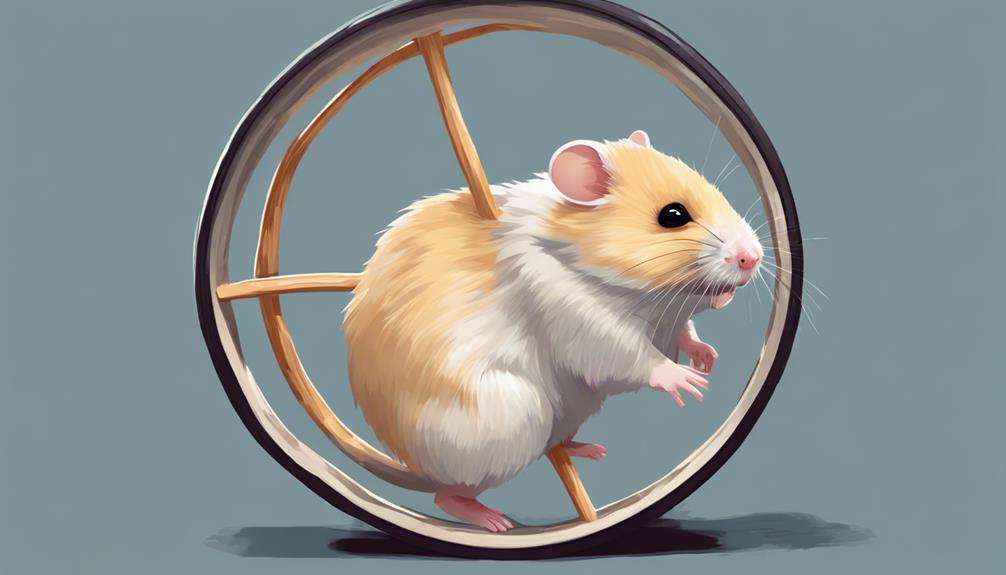
Originating from Mongolia and northern China, the Chinese Hamster is a distinctive species known for its longer, slimmer body compared to other hamster breeds. These pet rodents sport a unique black stripe down their back and a dark dorsal stripe on their tail, setting them apart visually.
While Chinese hamsters aren't as commonly found as other hamster breeds, their rarity adds to their appeal for rodent enthusiasts. If you're considering a Chinese hamster as a pet, keep in mind their active nature and love for climbing. Providing them with a spacious cage equipped with climbing accessories will keep these agile creatures happy and healthy.
Their inquisitive personalities make them fascinating companions, but they do require a bit more attention and care due to their specific needs. With the right setup and proper care, a Chinese hamster can bring joy and entertainment to your life.
Richardson's Ground Squirrel
Native to North America, Richardson's Ground Squirrels, also known as gophers, exhibit distinctive behaviors like standing upright on their hind legs to survey their surroundings for predators. These small rodents often live in colonies, forming a small group that works together to keep watch for danger. Richardson's Ground Squirrels have a complex communication system that involves various vocalizations and body postures to convey messages within their group.
During the winter months, these squirrels hibernate to conserve energy and endure the harsh weather conditions. Their burrowing habits not only provide shelter but also play an important role in aerating the soil and dispersing seeds, contributing to the ecosystem's balance. Additionally, Richardson's Ground Squirrels serve as an important food source for predators like hawks and foxes, highlighting their significance in the food chain of North America.
Observing these fascinating creatures can offer insights into the interconnectedness and resilience of wildlife in their natural habitat.
Short-Tailed Chinchilla
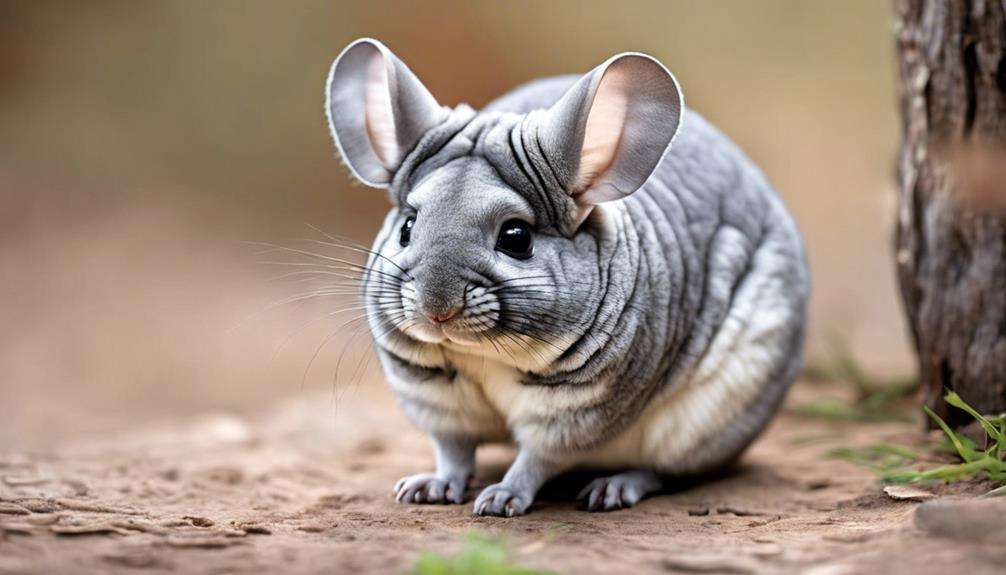
With their unique appearance and social nature, Short-Tailed Chinchillas make enchanting additions to any household, known for their rare breed traits and interactive personalities. These chinchillas stand out for their shorter tails compared to other species, native to the Andes Mountains. Their compact bodies and small ears give them a distinctive look that captivates many.
To keep them happy and healthy, Short-Tailed Chinchillas require spacious enclosures that offer opportunities for climbing and exploration. Their soft, dense fur coat needs regular grooming to prevent matting and guarantee their well-being. Social creatures by nature, these chinchillas thrive on companionship and interaction, forming strong bonds with their owners.
If you're looking for a small rodent with unique features and a loving temperament, the Short-Tailed Chinchilla could be the perfect fit for your home.
Egyptian Spiny Mouse
One distinguishing feature of the Egyptian Spiny Mouse is its unique spiny fur, setting it apart from other small rodents. These tiny rodents, native to North Africa and the Middle East, are known for their striking appearance and fascinating behaviors. Egyptian Spiny Mice aren't only adorable but also agile and can jump impressive distances, making them quite entertaining to watch. With a lifespan of around 2-4 years in captivity, they make for engaging and long-term companions.
To cater to their needs, Egyptian Spiny Mice require a spacious enclosure with plenty of hiding spots and opportunities for climbing. Their specific dietary requirements include a mix of seeds, vegetables, and insects to assure their best health and well-being. Providing a stimulating environment with proper nutrition is essential for these unique creatures to thrive. Consider adding these charming and active Egyptian Spiny Mice to your small rodent collection for a delightful and rewarding experience.
Brazilian Guinea Pig
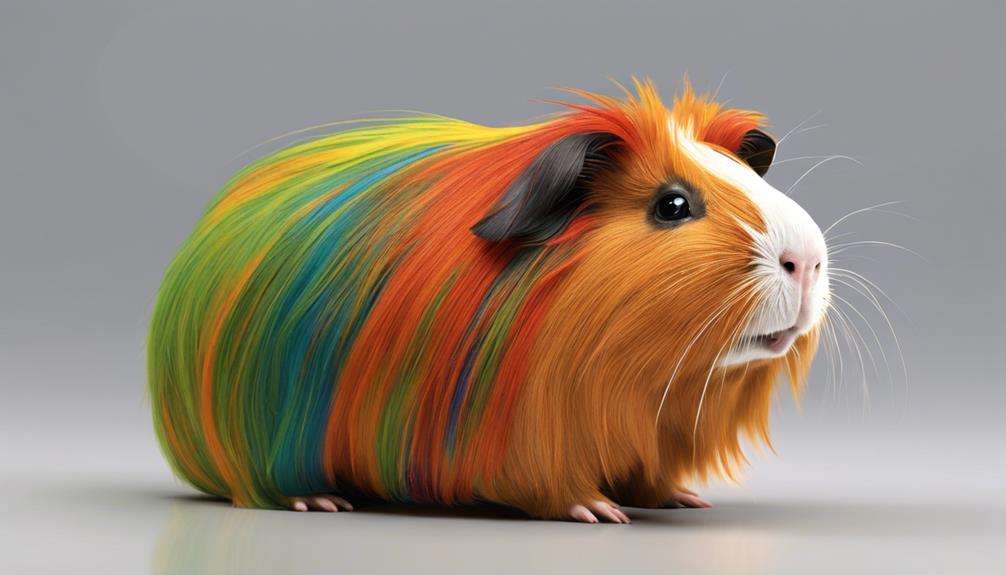
The Brazilian Guinea Pig captivates with its rare and luxurious long, flowing coat, making it a prized breed originating from Brazil. These guinea pigs are sought after for their unique appearance, with fur that's silky and elegant. Typically kept as show animals or pets, they require regular grooming to keep their coat in top condition. Owners must dedicate time to make sure the fur remains tangle-free and healthy.
The Brazilian Guinea Pig's long coat is a defining feature that sets it apart from other guinea pig breeds. Originating from Brazil, this breed stands out for its striking beauty and needs special care to maintain its luxurious appearance. Providing extra attention to grooming will guarantee that these guinea pigs remain healthy and their coat stays in best condition. If you're looking for a small rodent with a standout feature, the Brazilian Guinea Pig's long coat makes it a unique and fascinating choice.
Mexican Climbing Mouse
You'll be intrigued by the Mexican Climbing Mouse's unique physical characteristics, including its prehensile tail and specialized feet that aid in its excellent climbing abilities. Observing these mice navigate their vertical habitat with agility and precision is truly mesmerizing.
When it comes to caring for Mexican Climbing Mice, understanding their specific habitat requirements and providing opportunities for climbing and exploration are essential for their well-being.
Unique Physical Characteristics
With specialized adaptations for climbing, the Mexican Climbing Mouse, also known as the Mexican Tree Mouse, showcases unique physical characteristics that set it apart from other rodent species. These mice possess long, agile limbs and sharp claws, ideal for gripping onto branches in their arboreal lifestyle.
One of their most distinct features is their long, prehensile tail, which aids in balance and navigation while traversing through trees. Mexican Climbing Mice have a slender body, large eyes, and a bushy tail, all of which contribute to their adeptness in climbing. Their physical attributes have evolved to suit their arboreal habitat, allowing them to move with ease and agility in the treetops.
Habitat and Behavior
Climbing effortlessly among the high-altitude cloud forests of Mexico and Central America, the Mexican Climbing Mouse showcases remarkable agility and adaptability in its habitat and behavior. These mice are skilled climbers, often spotted ascending trees and maneuvering intricate terrains with ease. Their long, bushy tails play a crucial role in maintaining balance while climbing, aiding in their impressive tree-climbing abilities.
Mexican Climbing Mice are primarily found in high-altitude cloud forests, where they forage for a diet consisting of fruits, seeds, insects, and vegetation. Their unique habitat in the cloud forests has shaped their behavior, making them adept at maneuvering through the dense vegetation and utilizing their climbing skills to explore their surroundings effectively.
Care and Maintenance
To safeguard the well-being of your Mexican Climbing Mouse, it's essential to provide a secure enclosure with ample vertical space for climbing and exploring. Proper care involves ensuring the enclosure is escape-proof and contains climbing structures like branches or shelves.
Mexican Climbing Mice thrive on a varied diet consisting of seeds, grains, and vegetables, supplemented with occasional treats. It's important to maintain a clean living environment by regularly cleaning their enclosure and providing fresh water daily.
Pet care for Mexican Climbing Mice also includes social interaction and handling to keep them tame and mentally stimulated. With a lifespan of 2-4 years in captivity, providing consistent and appropriate care is essential for the health and happiness of these agile rodents.
Brush-Tailed Bettong
Brush-Tailed Bettongs possess unique physical features such as their distinctive brush-like tails, which aid in their swift movements.
Their habitat and behavior reflect their nocturnal nature and herbivorous diet, mainly consisting of roots, tubers, fungi, and insects.
Conservation efforts are vital to protect these marsupials from threats like habitat loss and predation by introduced species.
Unique Physical Features
With its distinctive brush-like tail and unique hopping gait reminiscent of a kangaroo, the Brush-Tailed Bettong, also known as the woylie, captivates observers with its physical features.
These small animals have a gray-brown fur coat that helps them blend into their surroundings, making them well-camouflaged in their natural habitat.
One of the most striking features of the Brush-Tailed Bettong is its large ears, which aid in enhancing their sense of hearing, important for detecting predators and finding food during their nocturnal foraging activities.
Additionally, their bushy tail, which is used for balance while hopping and grooming, adds to their charm.
Sadly, due to habitat loss and predation, these unique creatures are categorized as vulnerable in the wild.
Habitat and Behavior
Inhabiting dense forests, woodlands, and heathlands, the Brush-Tailed Bettong showcases a unique blend of habitat preferences and nocturnal behaviors. These small marsupials are skilled foragers, feeding on seeds, fruits, and insects within their preferred habitats.
During the day, they rest in nests constructed from grass, leaves, and bark. Brush-Tailed Bettongs play an important role in seed dispersal, aiding in the regeneration of plant species in their ecosystems.
However, these fascinating creatures face challenges due to habitat loss and competition with introduced species. Conservation efforts are essential to protect the Brush-Tailed Bettong population and preserve their important role in maintaining the biodiversity of Australian forests and woodlands.
Conservation Status
Due to habitat loss and predation, the conservation status of the Brush-Tailed Bettong is of utmost concern, with efforts underway to protect and restore their populations. Classified as Near Threatened on the IUCN Red List, these small marsupials native to Australia have seen declines in numbers.
Brush-Tailed Bettongs are critical for their ecosystem, aiding in seed dispersal and promoting plant diversity. Conservation efforts are essential to safeguarding this unique species, ensuring their survival for future generations. Initiatives focusing on habitat protection and restoration are key in combating the challenges these animals face.
Public awareness and support play a significant role in the success of these conservation endeavors. By addressing habitat loss and implementing effective conservation strategies, the Brush-Tailed Bettong can thrive once again.
Russian Dwarf Hamster
Russian Dwarf Hamsters are popular companion pets due to their petite size and sociable demeanor. They are among the smallest of their kind, typically reaching lengths of only 3-4 inches. These hamsters have a friendly and curious nature, making them ideal for families looking for small, interactive pets. With a lifespan of around 2-3 years, they require proper care and a suitable environment to thrive. Russian Dwarf Hamsters are active and agile creatures, enjoying toys, tunnels, and exercise wheels in their habitat to stay mentally and physically stimulated.
Despite their small size, Russian Dwarf Hamsters are relatively low maintenance pets. They need a well-balanced diet, fresh water, and regular social interaction for optimal health and happiness. Consider adding one to your home if you're seeking a small, charming companion that will bring joy and entertainment to your household.
Frequently Asked Questions
What Is the Best Small Rodent to Keep as a Pet?
When considering a pet rodent, assess your lifestyle and space. Rodent behavior and training vary; some require more interaction than others. A balanced diet and enrichment are essential. Research before choosing to confirm compatibility with your routine.
What Are the Most Intelligent Rodent Pets?
When considering rodent behavior and intelligence, exploring how these small pets showcase their cleverness is crucial. Their ability to learn tricks, solve problems, and navigate mazes highlights the potential for enriching training experiences.
What Is a Rare Rodent?
Rare rodents are endangered species needing conservation. Some have unusual markings or genetic mutations. Studying them gives insights into evolution and ecosystems. Your understanding and support are vital for their survival.
What Is the Cuddliest Rodent Pet?
If you're seeking a cuddly rodent pet, Degus are your best bet. These social creatures form strong bonds, live long, and can even learn tricks. Providing proper care guarantees a happy bond and rodent cuddle therapy.
Conclusion
Now that you've explored the fascinating world of unique small rodent breeds, imagine the joy of watching a Pygmy Jerboa leaping effortlessly through the air or the curiosity of observing a Brush-Tailed Bettong exploring its surroundings.
These enchanting creatures offer endless opportunities for learning and companionship, each with their own special traits and behaviors.
Embrace the wonder and excitement of caring for these extraordinary small rodents and discover the beauty of the animal kingdom in your own home.
